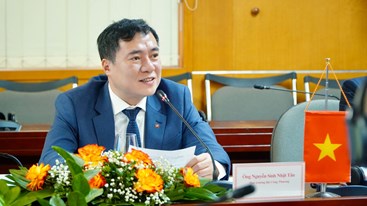Thursday, 25/04/2024 | 11:29 GMT+7
ANU has a partnership with a Chinese manufacturer to commercialise new solar cell technology. (ABC News)
The scarcity of high grade silicon is one of the things which pushes up the price of roof top solar panels. The majority of existing solar energy cells on the market rely on high grade silicon components.
Researchers from The Australian National University in Canberra have found a way to use more abundant lower grade silicon components to generate electricity from sunlight.

Lead researcher Dr Daniel Macdonald says the breakthrough will increase efficiency and reduce consumer energy costs.
"Most solar cells made from silicon today use P-type silicon, which is more resistant to radiation in space," Dr Macdonald said.
"That's totally irrelevant for terrestrial applications."
The research highlights the benefits of N-type silicon, which is less affected by the impurities that reduce efficiency.
The ANU and one of China's largest solar energy manufacturing companies, Trina Solar have formed a partnership to commercialise the technology within 3 years.
"We believe that this project will allow us to take some of our best innovations from our laboratory and actually implement them in industry, so that people can put them on their rooftops."
Dr Macdonald says the new silicon cells will be cheaper to manufacture and he's confident the technology will drive down the cost of solar electricity by up to 10 per cent.
"In collaboration with Trina ... we are aiming to develop 20 per cent solar cells. That compares with today's industry standard of typical P-type counterparts of around 18 per cent. Now that may not sound like a big increase, but effectively it means that for a solar module of the same surface area, you get 10 per cent more electricity out. That is a significant increment."
Dr Macdonald says the strategic partnership with Trina follows more than 12 months of talks, and he hopes it will endure.
"China will be the dominant manufacturing centre for photovoltaic modules in the foreseeable future, so that's a very valuable relationship for us."
The Federal Government is contributing $3million towards the total $11million project.
The Federal Minister for Resources and Energy Martin Ferguson says he is not worried about exporting the manufacturing of Australian breakthroughs overseas.
"As the pace of solar energy deployment actually accelerates globally it is imperative that Australia remains a leader in the field."
"We are not going to get thousands of jobs in manufacture. We are going to actually concentrate on high tech innovation and in doing so create the capacity, create additional jobs in the installation of these opportunities throughout the length and breadth of Australia."
Dr Huang Qiang of the Chinese firm Trina Solar noted the auspicious date of today's announcement.
"This day is a very, very nice day!"
"(The numeral) eight in Chinese means fortune and growth. Two means two parties."
"This is the meaning of the day. We are so happy to work with ANU on this project and we have set up an Australian office."
The Federal Government agency, the Australian Solar Institute (ASI) says the collaboration is a vote of confidence for Australian research.
Jenny Goddard chairs the ASI board.
"Solar is the worlds fastest growing energy market, and
global PV (photovoltaic) capacity has been increasing at an annual growth rate
of 40% since 2000," Ms Goddard said.
"Trina provides the platform for the world market to witness Australian innovation, and opens the pathway we hope, for future opportunities."
She described ANU's solar energy research team as world leading. The university has secured close to $18million in ASI grant funding to date.
abc.net.au








.jpg?w=367&h=206&mode=crop) Energy efficiency and conservation usage is an important aspect of the national energy development strategy
05/03/2024
Energy efficiency and conservation usage is an important aspect of the national energy development strategy
05/03/2024
 Vietnam - Denmark promote cooperation in the energy sector
Vietnam - Denmark promote cooperation in the energy sector
 Challenges and Opportunities to promote energy efficiency market in Vietnam
Challenges and Opportunities to promote energy efficiency market in Vietnam
 The Ministry of Industry and Trade requests government agencies to coordinate in organizing Earth Hour 2024
The Ministry of Industry and Trade requests government agencies to coordinate in organizing Earth Hour 2024
 Consultation on Energy Efficiency Boiler Catalogue and Wood Drying Guideline
Consultation on Energy Efficiency Boiler Catalogue and Wood Drying Guideline
 Son Ha Co., Ltd, applies energy efficiency and conservation measures
Son Ha Co., Ltd, applies energy efficiency and conservation measures
.png?w=367&h=206&mode=crop) Request for expression of interest - C2.1.13: Capacity Building on energy efficiency policies development
Request for expression of interest - C2.1.13: Capacity Building on energy efficiency policies development
 Phuc Kien Co., Ltd., is effectively implementing energy-saving measures
Phuc Kien Co., Ltd., is effectively implementing energy-saving measures